Erika Katalina Pásztor: from the ego to the eco
This essay takes its point of departure not from the Corpora Project itself1 , but from the viewpoint of a hypothetical visitor. This particular visitor is no stranger to technology and/or art and visual culture, and most probably s/he her/himself also produces various (not necessarily grand art) compositions. S/he will be the subject under examination in this text, the recipient who has become a gauge for this new thinking, and simultaneously a creative first-person subject.2
Figure 1. Corpora Project (source: YCAM press)
At first glance, it is not easy to decide exactly what Corpora is. The press release from the Yamaguchi Center for Arts and Media (YCAM) – the institution financing development of the project prototype – consists of only a type of technical description, not concerned with either interpretation or putting it into context. The technology in itself does not represent any sort of value, only becoming a vehicle for value in the course of its use. YCAM’s communiqué, choosing for us the path of value-neutrality, leaves it to the discretion of viewers as to what we might, or could, think upon seeing this visually captivating, self-expanding, complex structure.
Figure 2. Corpora Project (source: dNA)
Together with the emergence of the dominant new technologies of any age, the question of what we consider to be art – the recurring element in artistic discourse – and similar queries and debates accompany the thousand-year history of the relationship between architecture and technology.3 When today we encounter a coolly elegant technical wonder, we generally see the nebulous extrapolation of a future everyone has deemed elsewhere, or to which – not forgetting its aesthetic values – we ourselves also relate to with a cool, elegant aloofness. It is not a problem if we do not understand every detail, because the spectacle itself is interesting. It is as if we have arrived at a new vantage point from which to survey technological possibilities, and a landscape we have never seen before unfolds beneath us, changing before our very eyes. If we do not know how and by what rules the image is realized with the written algorithms, then we do not understand Corpora, as the body of internal laws for an artificial landscape-robot. We are limited, each in our own way: according to our talents, knowledge and the time at our disposal. In this way, the lowest common denominator – and at the same time, the most uncertain – remains the perceived image.
The landscape and its image
The creators of Corpora also intend to show the space-generating process ‘in situ’ and in progress, which places it at the center of interdependence between nature and humankind. From the viewpoint of the receiver, Corpora is an experience of visual complexity, generated by a simplified ontogeny-model that can be algorithmised; seen from here it hardly differs from familiar landscape experiences, or from existence within a natural or artificial landscape. A landscape takes shape through diverse effects and interventions that appear to be independent from each other and inexplorable, and it assumes its form just as we see it at a given moment and perceive it through our sensory organs. We do not have a precise knowledge of the landscape’s laws (codes) of change, and thus it is built upon all sorts of traditions of human intervention and experiences, the results of scientific research, technological innovations, and stochastic appraisals (often used by economists and engineers). Notwithstanding this, the Corpora-landscape is the image of a given, limited ontogeny, behind which stand correlations and rules – defined by the creators – the existence of a higher ordering principle is denied, and the independence and reciprocal capacities of the individual parts can be inferred.
Figure 3. Monte Sirti, Italy. (The author’s own image, made with a mobile telephone, 2007.)
We are only familiar with a fraction of the correlations underlying a natural landscape and its appearance, and while the question might be raised as to the extent to which we might achieve knowledge of the complexities, it is difficult to escape the elementary impact of an unfolding natural landscape – the thrillingly beautiful (mysterium tremendum)4 , and the shock of the SELF. A natural landscape (as an image) elicits the ‘fear of the unknown mixed with wonder’, and upon seeing Corpora this does not vanish either. We surmise, experience the unknown that has been rendered recognisable – and at the same time surmountable through the technology employed in this creation – in a way that says this is a phenomenon built upon precepts that we can only accept in part; both in spectacle and in the intimation of the knowledge underlying it, the work offers an experience of complexity similar to that produced by being in a natural landscape. Corpora as media artwork – from the side of the receiver – will test the relationship of the receiver’s Self to complexity through personal experience and cognition.5 But for how long can attention be maintained? And what can be attained through cognition?
Time and space
It must be taken into account that the average visitor will spend only a few minutes with an exhibited work. The time-based condition of existence sets the strictest limits on every act of reception, comprehension, learning and communication. One of the main obstacles to the acquisition of personal cognition and coherent knowledge is precisely the unprecedented profusion and complexity of content that we ourselves produce, and in which we have increasing difficulty in orienting ourselves unaided. Yet we can depend ever less on trustworthy mediators, because those institutions – schools and universities (universitas) which once provided the basis for the identity of an open individual, capable of free choice and of self-determination, are just as perplexed as the individual by the widening chasm between the time allotted to them and the volume of knowledge which can be accessed. The majority of collective information-filtering and valorising systems have failed, and the earlier positions of power based on access have dissolved, and today these are reconstructed on entirely different bases – e.g., across social networks. In real and virtual space condensed by networking, ever less time remains for the mapping of the real (temporal and spatial) connections between our thoughts and our personal evaluations. In this multi-layered content of the steady-state present, we remix the messages like DJs, so that we are simultaneously receivers and producers. Time, however, limits the mediation and recognition of individual (and collective) identities – values – that aspire for significant differences in essence, though they are increasingly schematic.6 It is thus a central question: with what do we spend our time? In the European Union the average available to us as free time is just 4.5 – 5.5 hours per day.7 A million and one events and services compete for these few hours of attention, and compared to the time at our disposal, the overabundant variety available is staggering.
Figure 4. Members of the public organised by ÓVÁS! demonstrate against the demolition of the Hild House, Király u. 40 on 21 February 2006. (source: epiteszforum.hu). The civilians – as a coalition – are individuals of diverse identity who, aiming to represent some recognised common (collective) interests, form an alliance and articulate their consensual thoughts.
Knowledge often works against experience. When knowledge renders phenomena transparent, they are lost from collective mystery, and it generates new enigmas due to the temporal and recipient limitations of the Self. The receiving Self does not open, but closes. The relationship of the Self to time and complexity is ambivalent: the more intensive the new impacts that reach it – those that demand the integration of new knowledge – the more emphatically the signs of closing – escape – manifest themselves. The inconsistent condition produced leads towards the representations and social networks of the already familiar and accepted knowledge of the receiving Self; in this way, a new artwork, whose realisation and comprehension also demands manifold access, will find an ever smaller audience. Although the majority of exhibitions (not only art) related to technology generate considerable interest, more qualified, insightful and critical reflections on the level of interactive spectacle only emerge in more select circles. This circle is small even at an international level, and it is generally the same audience – nota bene – that appreciates their achievements. Such exclusive valorization is true for nearly every specialised audience – local and global. The specialists who use technology intensively have established global villages8 , and the internet has simply accelerated their proliferation. Those who are like-minded associate with one another, forming their identities and reinforcing their own knowledge and beliefs across their social networks.
All this is interesting, of course, because while we experience the closedness of the individual rather than its openness, in the cacophony of the identities competing with time (and each other), everyone desires broader social respect9 : everyone – from architects, economists, engineers, lawyers, through to artists, activists and politicians – who feels that they might exert a small influence on changes in their wider and/or narrower environment. The age of communication for this influence focuses on acquisition, while we have to see that on the potential receiver side, considering any kind of newly recognised correlation, it functions ever less efficiently. This attitude of the closing recipient is true not only for the achievements of art, design or science, but for all images of complexity (competing for attention in the market). This is realised most in those regulating – i.e., consensus-seeking – processes, whose aim would be exactly the management of complexity.((See also: The protraction and circumstances of the birth of the Kyoto Agreement that was finally signed in 2007. The conflicts of reigning powers and public interest generate stories of similar political absurdities in not only international, but also local situations. Even today the inclusion of increasingly popular Hungarian civil organisations (NGOs) in decision-making processes is an obligation issuing from the legal system – irritating the functioning of existing power structures – and not the result of a consensus-seeking process. In practice, these civil organisations are viewed much rather as nuisances and annoying obstacles than as partners. )) And while our days begin with global warming and end with the news of the extinction of one species or other, and while we struggle in the meantime with every item in a flood of waste and with the problem of recycling, we somehow manage to give individual responses, but in the absence of collective responses based on consensus and moderation, (on the level of the individual) we experience all this as a hopelessly merciless and cynical situation.
The shift of the hierarchy of spaces
In light of this we cannot make the error of placing recognition – and its most diverse of outward forms and indices – where honour should be in our scale of values, as do the majority of players on the economic scene. The selection of the least fit that derives from the schematism of the various support strategies (private, public and media), exploits its own individual and institutional stars within nearly every field of education, culture and science, who serve as role models and benchmarks for those who find themselves on the periphery. In the global environment – which naturally can be reduced further into partial complexities along political, economic and social lines of force and geographic borders – complicated centre-periphery relations were established, between which the perpetual and multi-layered simultaneous flow of knowledge, labour and capital is symptomatic.
Figure 5. Hungary joins the EU, with the unveiling of the “Time Wheel” and a street party. The Time Wheel measures the passing of time from midnight on 1 May 2004. (source: epiteszforum.hu) Hungary’s accession to the EU –regardless of economic advantages and disadvantages – signified a shift towards a symbolic meta-centralised site, as well as the hopes and expectations tied to it.
The dynamics of the movement between centres and peripheries determines the means by which artworks (ideas, projects, experiments, innovations, etc.) in a given environment can be realised – or, to the contrary – which have no chance of realisation. The most frequent question raised by the ambitious creative Self is: Where is the minimum relevance required for the creation of a given work, and if it is not where the artist is, then in what direction should h/she move? Artists, designers and scientists over the past 100 years typically moved toward the centres where they saw more chance of their ideas being realised. The Corpora Project apparently moves in the opposite direction. For all intents and purposes, it shifts from the centre to a broader place offering the possibility for visibility within an international context, when it will be on view in the Hungarian pavilion. For Corpora, this exhibition space has a value greater than that of centres – a meta-central value. The intensive networking continuously transforms the hierarchy not only of the spaces of production, but also of reception (acceptance).
Site-specific identity model
As regards Corpora, there is no doubt that it has sprung from a milieu in which it is appropriate to keep a distance between technology, technology-based arts and local/global social problems. Neither the creators of the project, nor the insightful audience have a need for this. Corpora’s authors, nevertheless, produce an abstract, augmented reality in the Hungarian Pavilion, for which – whether intentionally or not – there are references for the external, social context. Corpora has a message for Hungary through the Hungarian Pavilion, which is complemented by ‘site-specific’ symbolic content.10 For all that – by chance or otherwise – a functional analogy may be imported from the technical construction of the work, which it would appear could also be the model for the identity-building strategy of the receiving-creating Self.
Together with its own technicism and outsiderness, Corpora, here (in the Hungarian Pavilion), holds a mirror up to local Hungarian problems that are difficult to manage, sensitive, and in many cases not accepted. Refraining from comparisons, these problems derive chiefly from damage to our own identity, and spring from anxieties from our own peripheral image, behind which there is a lack of critical appraisal in the global context and the courage to consider ourselves from a more distant perspective. In our linguistic and communicational segregation, and with our territorial behaviour, we have constructed the culture of an autarchy (this might be a slight overstatement), which it seems now might begin to dissolve in the complex global centre-periphery networks. Within this metamorphosis, no single individual or collective identity remains untouched. It is clearly visible how these processes are accomplished in every corner of the world, but there are larger territorial units that are similar beyond their diversity. Our Eastern Europeanness defines a certain scope for movement, which in turn determines a type of creative (and at the same time, recipient) praxis, and which – and perhaps this is the most important – positions the formation of a much more courageous, globally critical viewpoint. We do not avail ourselves of this at all; we do not dare to. We rather subsist in comparisons that frustrate our proximity to our neighbours, and not in the search for similarities built upon reciprocity.
Figure 6. CiS sensors (resource: dNA, YCAM)
Corpora’s image of complexity within me – as in my recipient Self – has thus gained another dimension, to a certain extent. The critical aspect is indispensable for the comprehension of the complexities necessary for the maintenance and further development of the mental ‘Super-eye’.11 There is no easy, relevant, site-specific critical viewpoint to be found in the complicated centre-periphery networks of the global milieu – in this new social complexity. The critical attitude – for me, as the receiving and creating Self of the exhibition visitor – implies the dynamism and self-reflection of the identity; i.e., it is not enough to divine once who we are and, depending on others, what we might want: this is a task that demands constant rethinking and self-organizing. The image fed and simplified by mainstream communication, which is constructed from the comparisons between alleged or real peripheries with alleged or real centres, is infinitely false. It is not the constant measuring up, but the self-building, self-organising, site-specific identity, open to external influences, that we should place at the centre of the creative Self, expanded with globally critical viewpoints (in the geopolitically alleged or real peripheral position). The Self that builds a dynamic, interactive relationship with itself and its environment is similar to a nascent and perishing node within the structure of Corpora: an integral part of the complexity coming into being, of a local and simultaneously global ecosystem. I can be not merely a viewer of Corpora, and I can exert an influence not only on its functioning. Identifying with a discretionary node – it is not the presence of a thrillingly higher power (tremendum), but rather – my own active dependency, i.e. integral part-icipation in the complexity that will become visible through it.
- A detailed description of Corpora can be found in the Corpora Concept Book, and its developmental process has been documented on the site: www.corpora.hu. Presentation of the project in Hungarian can also be read in this catalogue, following the introduction by curator Gyula Július. At the time of writing, the present author could only access the artwork through secondary representations. [↩]
- While the “ego” used in the title originates in the expression egocentric, and also refers to Freud’s theory developed around personality structures, in the essence of this text, I took as my departure point the phenomenological comprehension of personality following from my own subjective experience of the individual (e.g., in connection with media artworks). The “eco” prefix refers to the ever accelerating and expanding content in connection with ecology, which the personality influenced by her/his experience (independent of artistic experience) is compelled to confront in some form. [↩]
- In his essay “The Work of Art in the Age of Mechanical Reproduction” (source: Walter Benjamin: Gesammelte Schriften. Band I.2. Abhandlungen. Herausgegeben von Rolf Tiedemann und Hermann Schweppenhäuser. Suhrkamp Verlag, Frankfurt am Main, 1980, pp. 471-508), Walter Benjamin also mentions the fruitless arguments that have emerged in connection with photography: whether or not it can be considered an art. From the perspective of our train of thought, however, it is not the revival of such or similar debates (that have dragged on until the present day) that is essential. It is much more interesting to set out from Benjamin’s thesis, according to which: “mechanical reproduction of art changes the reaction of the masses toward art”. This recurs in Olga Goriunova’s essay “When New Media are No Longer New and Everyone Creates on the Internet” (in: eds. G. Stocker, C. Schöpf: Simplicity: Ars Electronica 2006. Hatje Cantz Verlag, Ostfildern, pp. 44-49), in connection with new media art: “If there is a crisis in new media art, it is also because people do not need artists any more to guide them through media experiences and to shape media experiences for them.” Commencing with the modern age, the increasing complexity of building – city – and landscape architecture has produced a professional elite which today covers an extremely wide spectrum, and which, in making decisions in connection with the built environment, alongside the political-economic authorities, carries the greatest influence. All the same, vernacular architecture “without architects” has always endured in some form, characterised as a by-product of migration – radically transforming the local spaces of the processes of globalisation – the architecture of the ever increasing shadow cities of millions: barrios and slums. This architecture – originating in a lack of access to land, capital, developed technology and associated (professional) knowledge, does not satisfy the ephemeral function of shelter even on a small scale, and reveals much of its relation to the architecture of the masses, as to art. (See: Caracas: The informal city. Film by Rob Schröder and Alfredo Brillembourg, Hubert Klumpner architects. VPRO, International Architecture Biennale Rotterdam, U-TT Caracas production, 2007.) It would be worth rethinking a change in the relationship of the masses living in such an unusual cross-section of widely disparate social class spaces, to art, design (including architecture) and technology. [↩]
- “(Rudolf Otto) finds the feeling of terror before the sacred, before the awe-inspiring mystery (mysterium tremendum), the majesty (majestas) that emanates an overwhelming superiority of power…”. From: M. Eliade: The Sacred and Profane: The Nature of Religion, p. 9, trans. Willard Trask (Harcourt Trade, 1959). [↩]
- “The more deeply the image is saturated with the atmosphere of the tremendum, the less it is inclined to be a spectacle any longer, but rather to be the opposite: the image will be the viewer, and the individual, who stands before it, will be the spectacle. The image is the tremendum – the presence of the thrillingly higher power, and thus, it is not the image that stands before the individual, but the individual who stands before the image.” B. Hamvas – K. Kemény: Forradalom a művészetben. (“Revolution in Art”, Baranya Megyei Könyvtár, 1989. p. 32 Second, corrected edition. First edition: 1947, Misztótfalusi). Hamvas brings the experience of the viewer receiving the artwork in relationship with the notion established by theologian Rudolf Otto, and the expression mysterium tremendum used in the description above by religious historian Mircea Eliade in his notion of the numinous. According to Otto, the a priori category of human cognition is extreme dependence and the feeling of creation, the experience of thrilling beauty. Hamvas separates the spectacle-experience from the shocking experience, which proceeds from the impact of the artwork on the recipient. [↩]
- “Everywhere we encounter value judgments – they are present everywhere, even in the exact sciences. But there, perhaps, man can forget about them: if he likes, he doesn’t have to acknowledge them in every moment. But I think … that in order to assure the possibility for an authentic human image, for the authentic interpretation of man, of living creatures and of the universe, we first need to make constant value judgments. … We have the task before us to construct a virtually new culture from a certain point of view, in the face of three hundred years of triumphant development, whose basis was another method: a method that reduced things to inadequate elements.” Conversation between Carl Rogers and Mihály Polányi at the conference entitled, “Man and the Science of Man”, in 1966 at the University of California – San Diego (eds.: W. Coulson, C. Rogers, Man and the Science of Man. Columbus, Ohio: Charles E. Merrill, 1968). [↩]
- Based on the detailed cultural statistics published on the first occasion by the statistical bureau of the European Commission, EUSTAT, people spend the majority of their free time (77-87%) in front on the television and/or videos, and they use only 4-9% of it to visit lectures or other cultural events. It is typical that for instance, we cannot measure the proportion of activities related to art, because it was not possible to separate these from other activities. This is the aggregate data measured in eight countries of the European Union (DE, ES, FR, IT, FI, SE, UK, NO). Source: Eurostat Pocketbooks. Population and social conditions. Cultural Statistics 2007, p.156. http://epp.eurostat.ec.europa.eu [↩]
- Marshall McLuhan, in his book entitled The Gutenberg Galaxy, published in 1962, introduced the term “global village” in connection with electronic media, as the functioning of a vascular system covering the entire world with its network, and in connection with this, the so-called tribal organisations, as the appearance of the most important sources of power. “… the telegraph and radio, the globe concentrated, spatially, into a single large village. Tribalism is our only resource since the electro-magnetic discovery.” Source: McLuhan M. The Gutenberg Galaxy: The Making of Typographic Man. p. 219 (University of Toronto Press, 1962). [↩]
- Over the past decade, we have been able to see significant positive changes in the field of architectural communication in Hungary. Active players provide thorough analysis on the internet, as well: Turai, Balázs: Az építészet nyilvánossága az interneten (“The public space of architecture on the internet”). Régi-új Magyar Építőművészet, 2006/4. Utóirat (Postscript) appendix. In the public sphere of professional values and the insufficiency of social respect, Maurizio Cohen’s The Dreamlife of Belgians formulates a sharp-toned critique of contemporary European architecture in a book comprising the essays of invited architectural critics from each member state. According to Cohen, market-based, profit-oriented, banal construction has virtually swallowed public space and leaves no space whatsoever for the communication of architectural values. Eds.: S. Lemaire, C. Pourtois, C. Vermeulen, I. Murray: looking at european architecture: a critical view pp. 70-75 (CIVA, Brussels, 2008). [↩]
- See also: “Utopian Traditions: From an architectural model to a possible alternative”, in which the author similarly refers to a retroactive message, illuminated from an architectural aspect. [↩]
- A new space-mapping technology developed by dNA and employed in the Corpora Project, with which viewing of an object (“a world”) becomes possible from inside and not only from an exterior viewpoint. The principle of the super-eye can be shown with a spherical surface within which there are countless cameras (offering a unique perspective), and these see the space from every direction simultaneously. All the images generated this way (through the various coordinate systems of the various viewpoints) are transformed with special procedures into a given coordinate system.
[↩]
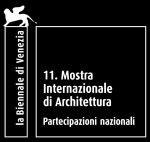



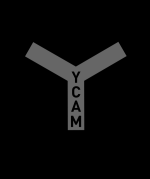


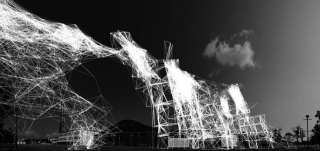
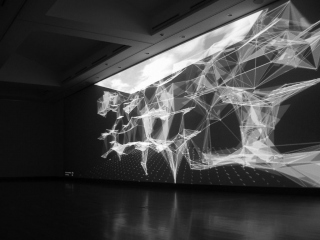
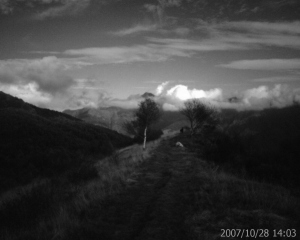

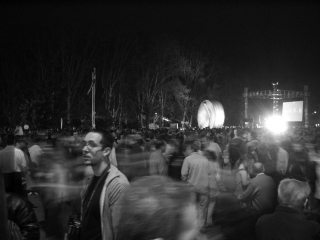
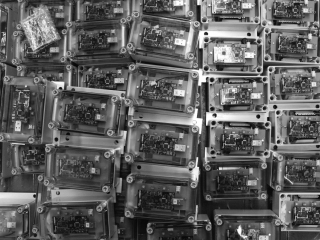

Leave a Reply
You must be logged in to post a comment.